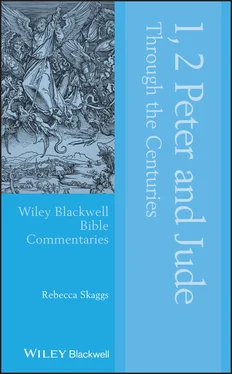Many current scholars also focus on the phrase “gird for action” (or be prepared). The second participle “be alert” or “be sober” underscores the sense of intensity in the exhortation. It is not clear whether the adjective “perfect” is modifying “sober” (live in “perfect alertness,” extending to all aspects of behavior, akin to “pay attention”, e.g., Hort, 1898; Michaels, 1988: 55; Bauer et al., 1957: 810) or to “hope” (“perfectly set your hope,” suggesting “set your hope without hesitation or faltering”. See Kelly, 1969: 66; Selwyn, 1958: 140). The admonition “be sober” usually refers to moderation in the use of alcohol, but many modern scholars understand it in its broader sense of self‐control and clarity of mind (e.g. Kelly, 1969: 66). These qualities are needed in order to enter into the fulfillment of anticipated hope. Others follow some of the early thinkers, such as Bede, and read it as a baptismal challenge – as baptized Christians we are now obligated to live a certain kind of life before God, free from the pagan past and now living an existence characterized by holiness. Kelly makes the point that holiness here is not just ritual purity as in the Old Testament, but is “the freedom from sin and absolute moral integrity which fellowship with God makes imperative” (Kelly, 1969: 69). Peter provides practical applications – avoidance of slander, impure associations, drunkenness, violence, abominable pride, and so on (Kelly, 1969: 69; Selwyn, 1958: 141).
From his perspective as a writer, Emerson is impressed with Peter’s emphasis on holiness and applies his exhortation to the church of all time. On the occasion of the dedication of the Second Church Vestry in Boston, Mass. on February 28, 1831, Emerson speaks about the purposes for the erection of the hall and cited 1 Peter 1:16 in particular, that the hall should be used to contribute to holy living, “we should be holy as he is holy” (Emerson, 1992: 270).
The Message Bible, an idiomatic translation, expresses an interesting dynamic sense of the whole passage:
So roll up your sleeves, put your mind in gear, be totally ready to receive the gift that’s coming when Jesus arrives. Don’t lazily slip back into those old grooves of evil, doing just what you feel like doing. You didn’t know any better then, you do now. As obedient children, let yourselves be pulled into a way of life shaped by God’s life, a life energetic and blazing with holiness. God said, “I am holy, you be holy.” (MSG)
The Heidelberg Catechism (l563), primarily interested in Christ’s work of redemption through his blood, omits the reference to the readers’ redemption from their “past futile existence” (Pelikan II, IV: 435). The Dordrecht Confession (1632), reflecting the later radical Reformation era, is similar: “The church of the living God he bought and redeemed with his own precious blood” (ibid.: 778). In contrast, the earlier Catechesis and Confession of Polish Brethren (1574) includes even more of the ideas of the verse
(Pelikan II, IV: 727).
This passage has influenced popular music as well. In 1950, the folk singer and writer Bob Dylan included numerous times the phrase “the blood of the Lamb” in his album “Saved ” (lyrics are available online). Dylan’s interviewer Gilmour explains, however, that Dylan does not intend to express any particular message by using biblical words or phrases in his music, that his hearers will interpret the meaning themselves (Gilmour, 2004: 120). His use of these phrases from 2 Peter does indicate that this passage made an impression on him.
Verses 17–23 are used in the lectionaries for the Easter season of many faith groups: the Revised Common Lectionary is used by churches all over the world, for example by the Roman Catholics, the Episcopalians, the Lutherans, and the United Methodists (see Blass and Debrunner, 1961; textweek.com/1, 2 Peter.htm; Choral Literature for Sundays and Seasons , 66).
Peter continues with the implications of the holy life – a life typified by holiness is also characterized by love of one another. Because God is holy, we must be holy; because the Word is living and abiding, we should abide in holiness and demonstrate brotherly love. Although the word is philadelphion (literally “brotherly love”), it should be understood in a generic sense to include women as well. “Sibling love” would perhaps be better (Michaels, 1988: 73). Peter uses Isaiah 40:6–8 as a “centerpiece” to link this section together (vv.23–25): the perishability of human existence, like the transient grass, contrasts remarkably with the everlasting and dynamically abiding word of God.
The early thinkers are concerned with the nature of this holy life; what it looks like in practical terms. Hilary of Arles makes a point: “True purity comes from within. If the soul is clean, the body will be cleansed as well” ( Intro. Comm. on 1 Peter , PLSupp 3: 87: ACC). Oecumenius is more concerned with the connection between the power of the Spirit and our behavior among one another ( Comm. on 1 Peter , PG 119: 528: my tr.).
Current scholars are also interested in the focus of this passage on the life of holiness and understand the passage in a variety of ways .Green (2007: 50–52), using historical and social‐scientific methodology, elaborates on the multifacetedness of ancient conversion.
Other scholars such as Michaels are intrigued by the language used: that the perfect tenses of agnizo (consecrate, purify, v.22), anagennao (give new birth, v.23), and the aorists of apotithemi (put off, v.21) and geuomai (yearn, v.23), along with the imagery of seed (v.23) and growth (v.22), convey that salvation is both in the present and something we are anticipating (Green, 2007; see also Michaels, 1996: 251).
Others argue that the entire epistle is a baptismal liturgy with this passage (vv.22–25) being the “baptismal dedication delivered by the officiant following the actual baptism” (Martin, 1992: 36). Boismard (1956: 339–352) modifies the theory by suggesting that rather than the epistle being entirely a liturgy (Priesker, 1951: 152–156; Cross, 1957) or a homily (Perdelwitz, 1911), it contains several fragments of a primitive baptismal liturgy. He suggests that vv.22–25 is one of four baptismal hymns used by Peter.
Various catechisms express ideas from this passage. For example, the Heidelberg Catechism (1563), in answer to Question 65, says, “Since, then faith alone makes us share in Christ and all his benefits, where does such a faith originate?” The answer paraphrases 1:23: “The Holy Spirit creates it in our hearts by the preaching of the Holy gospel and confirms it by the use of the holy sacraments” (Pelikan II, IV: 441). The Brief Statement of the Evangelical Synod (1932) comments on “Conversion”: “All men, since the fall, are dead in sins … Hence, Scripture calls the faith of man, or his conversion … a new birth by the gospel, 1 Pet. 1:23–5” (Pelikan III, V: 491). The Statement of Belief of the North American Baptist Conference (1982) is more specific in terms of the nature of scripture: “We believe the Bible is God’s Word given by divine inspiration … it is trustworthy, sufficient, without error – the supreme authority and guide for all doctrine and conduct” (1 Pet. 1:23–25) (Pelikan, ibid.: 809).
Our author now addresses the new life of holiness by using another metaphor, “taking off,” such as in “removing clothes” ( apotithemi , cf., also Rom. 13.12; Col. 3.8; Jas. 1.2). The readers, having “taken off” their past evil and deceitful ways (v.21), will now need to replace these with love ( agapao ), harmony, and loyalty. Peter emphasizes the imagery of family – they are now relatives with God himself as Father (vv.1:2, 3, 17) (Green, 2007: 51; see also van Rensburg, 2004: 387–388). Here, their new existence of “brotherly love” stands in marked contrast with their past state. Whereas they were once alienated and strangers from God, they are now “aliens and strangers” within their society because they are chosen by God (reiterating the notion from vv.1–2). Finally, this new existence grows out of, and is sustained by, the “word that was preached to us” (v.25).
Читать дальше












